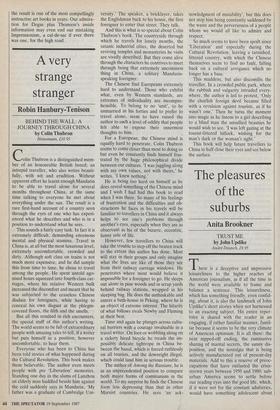Contriving the natural
Norbert Lynton
THE PRIVATE DEGAS by Richard Thomson Herbert Press, £12.95 D egas is counted an Impressionist and did exhibit with them in the 1870s and 1880s. Yet his priorities and methods were never theirs. That business of taking paints and canvases out of doors to catch nature's
' After the Bath' (1905) volatile light and colour struck him as silly. What had art to do with nature, nature with art? Truth is an additive, not a basic ingredient; art is artifice, and calls for deceit and cunning.
The cover of Richard Thomson's book is 'After the Bath', one of Degas' series of pastels of women spied at their mainte- nance routines, stepping out of baths, drying themselves, having their hair brushed. The figure is drawn clumsily as though Degas had forgotten he could draw like Raphael. She makes a neat enough diamond shape within the rectangle, but that involved humping her right shoulder up and withering her left leg. Light and shadow lend some solidity and prevent her disappearing in the artist's web of yellow, green and violet strokes and scribbles. Yet the whole thing steals over our senses like a Mozart aria, a perfect meeting of artistry and human experience.
Contemporaries knew the series was an affront to women and to the spectator. Who are these creatures? Why picture them? There were time-honoured reasons for showing bathing women as art. Call them Diana and her nymphs, and at once we are participants in a drama played between gods and mankind before time began. Degas' women are anonymous, faceless even, ordinary, indoors and now. That makes us peeping Toms, nervous clients perhaps, where we might have been Actaeon and gone down famously. Huys- mans, no shining moralist, said these pic- tures 'reek of the stumps of the maimed, the embrace of the prostitute'. How can we love them so much?
Renoir knew what he was looking at and called the series 'a piece of the Parthenon'. Where the fellow painter went by instinct, Richard Thomson has followed instinct into thorough-going research. His book takes us behind the scenes, into Degas' wardrobe and props room, and lets us watch his rehearsals. The young woman leaning forward to dry herself is one of his stock figures, daughter of a bereaved woman in a grandiose Delacroix. Those racehorses were sired by plaster casts of the Parthenon frieze out of Muybridge's Animal Locomotion photographs and Goz- zoli's frescoes of the Medici as magi. Even those ballet dancers — surely these stretch- ing, scratching, flopping girls are from life?
are caught in the poses of ancient statues.
Every page of this crisply written and well illustrated book has surprises for us. Directly and indirectly it illuminates much else, Degas' supposed misogynism for instance, but Thomson works with and through specific examples and practices; the result is one of the most compellingly instructive art books in years. Our admira- tion for Degas plus Thomson's inside information may even end our mistaking Impressionism, a cul-de-sac if ever there was one, for the high road.



































































 Previous page
Previous page